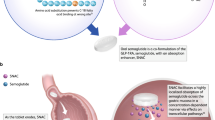Abstract
The metabolic syndrome leads to cardiovascular disease and type 2 diabetes mellitus, through multiple risks, such as insulin resistance, dyslipidemia, hyperinsulinemia, and hypertension. It also represents a disorder of partial genetic background as mutations of the peroxisome proliferator-activated receptor-gamma (PPAR-γ). Thiazolidinedione agonists for the PPAR-γ system are effective in control of insulin resistance and diabetes. Telmisartan has a molecular structure that imparts partial agonist properties with the PPAR-γ molecule, which results in reductions in glucose and lipid metabolism. Administration of telmisartan to rats on a high-fat, high-carbohydrate diet leads to reductions in glucose, insulin, and triglyceride levels. The results imply that the ARB agent, telmisartan, could treat both the hemodynamic and metabolic aberrations seen in subjects with the metabolic syndrome, such as insulin resistance, glucose intolerance, and hypertension.
Similar content being viewed by others
References and Recommended Reading
Benson SC, Pershadsingh HA, Ho CL, et al.: Identification of telmisartan as a unique angiotensin II receptor antagonist with selective PPAR-gamma-modulating activity. Hypertension 2004, 43:993–1002. The first paper to show structural similarity between telmisartan and the PPAR-gamma system, its effect on adipogenesis, and its ability to reduce metabolic dysfunction in rats with the metabolic syndrome.
Schupp M, Janke J, Clasen R, et al.: Angiotensin type 1 receptor blockers induce peroxisome proliferator-activated receptorgamma activity. Circulation 2004, 109:2054–2057. This study confirmed the effect of telmisartan and, to a lesser extent, irbesartan on adipocyte differentiation. Most importantly, by using an AT1 receptor-deficient model, they showed that the effect of ARB agents on PPAR-γ was independent of angiotensin II AT1 receptor binding.
Pershadsingh HA, Kurtz TW: Insulin-sensitizing effect of telmisartan. Diabetes Care 2004, 4:1015–1016.
Okada K, Hirano T, Ran J, Adachi M: Olmesartan medoxomil, an angiotensin II receptor blocker ameliorates insulin resistance and decreases triglyceride production in fructose-fed rats. Hypertens Res 2004, 27:293–299.
Derosa G, Cicero AF, Bertone G, et al.: Comparison of the effects of telmisartan and nifedipine gastrointestinal therapeutic system on blood pressure control, glucose metabolism, and the lipid profile in patients with type 2 diabetes mellitus and mild hypertension: a 12-month, randomized, double-blind study. Clin Ther 2004, 26:1228–1236.
Derosa G, Rogonesi PD, Mugellini A, et al.: Effects of telmisartan compared with eprosartan in mildly hypertensive, type 2 diabetic patients on blood pressure control, glucose metabolism, and lipid profile: a randomized, double-blind, placebo controlled 12 month study. Hypertens Res 2004, 27:457–464.
Lindholm LH, Isben H, Borsch-Johnson K, et al.: Risk on new onset diabetes in the Losartan Intervention For Endpoint Reduction in Hypertension Study. J Hypertens 2002, 20:1879–1886.
Julius S, Kjeldsen SE, Weber M, et al.: Outcomes in hypertensive patients at high cardiovascular risk treated with regimens based on valsartan or amlodipine: the VALUE randomized trial. Lancet 2004, 363:2022–2031.
Yusuf S, Pfeffer MA, Swedberg K, et al.: Effects of candesartan in patients with chronic heart failure and preserved leftventricular ejection fraction: the CHARM-Preserved Trial. Lancet 2003, 362:777–781.
Kurtz TW, Pravenec M: Antidiabetic mechanisms of angiotensin-converting enzyme inhibitors and angiotensin II receptor antagonists: beyond the renin angiotensin system. J Hypertens 2004, 22:2253–2261. An excellent review of the comparative metabolic effects of ACE inhibitors and ARBs from basic research to clinical trials.
Grassi G, Seravalle G, Dell’Oro R, et al.: Comparative effects of candesartan and hydrochlorothiazide on blood pressure, insulin sensitivity, and sympathetic drive in obese hypertensive individuals: results of the CROSS study. J Hypertens 2003, 21:1761–1769.
Lindholm LH, Persson M, Alaupovic P, et al.: Metabolic outcome during 1 year in newly detected hypertensives: results of the Antihypertensive Treatment and Lipid Profile in a North of Sweden Efficacy Evaluation (ALPINE study). J Hypertens 2003, 21:1563–1574.
Zimmermann M, Unger T: Challenges in improving prognosis and therapy: The Ongoing Telmisartan Alone and in Combination with Ramipril Global Endpoint Trial Programme. Expert Opin Pharmacother 2004, 5:1201–1208.
Yusuf S, Gernstein H, Hoogwerf B, et al.: Ramipril and the development of diabetes. JAMA 2001, 286:1882–1885.
Prisant LM: Preventing type 2 diabetes mellitus. J Clin Pharmacol 2004, 44:406–413.
Takeda K, Ichiki T, Tokunuo T, et al.: Peroxisome proliferatoractivated receptor gamma activators downregulate angiotensin II type 1 receptor in vascular smooth muscle cells. Circulation 2000, 102:1834–1839.
Yamagishi S, Takeuchi M: Telmisartan is a promising cardiometabolic sartan due to its unique PPAR-gamma-inducing property. Med Hypotheses 2005, 64:476–478.
Author information
Authors and Affiliations
Rights and permissions
About this article
Cite this article
Tuck, M.L. Angiotensin-receptor blocking agents and the peroxisome proliferator-activated receptor-γ system. Current Science Inc 7, 240–243 (2005). https://doi.org/10.1007/s11906-005-0019-y
Issue Date:
DOI: https://doi.org/10.1007/s11906-005-0019-y




